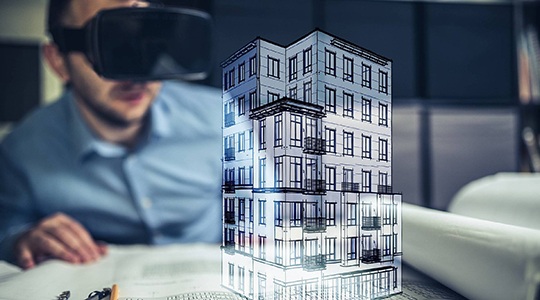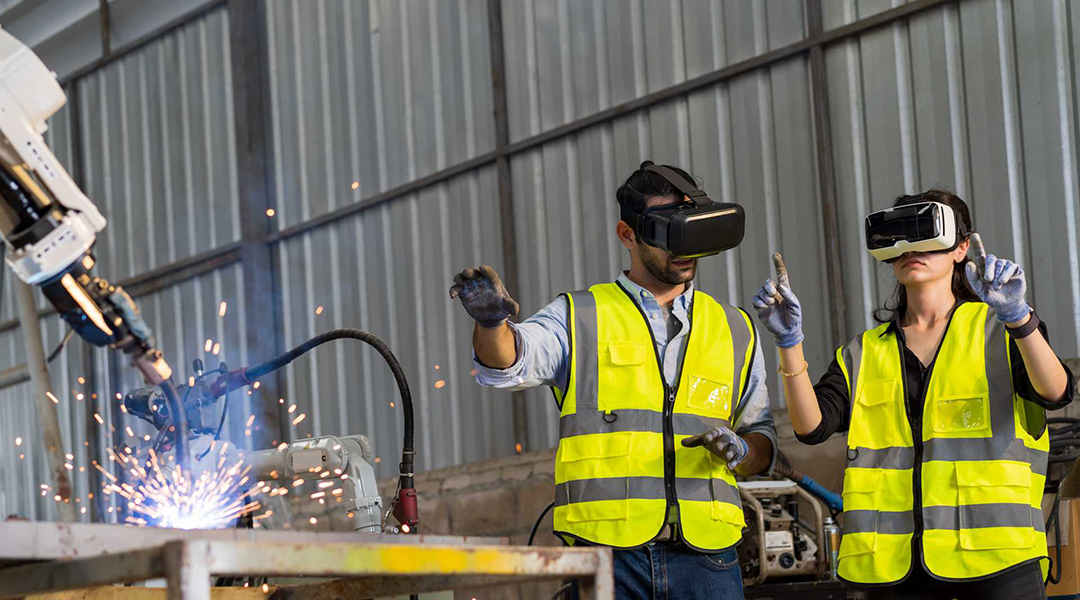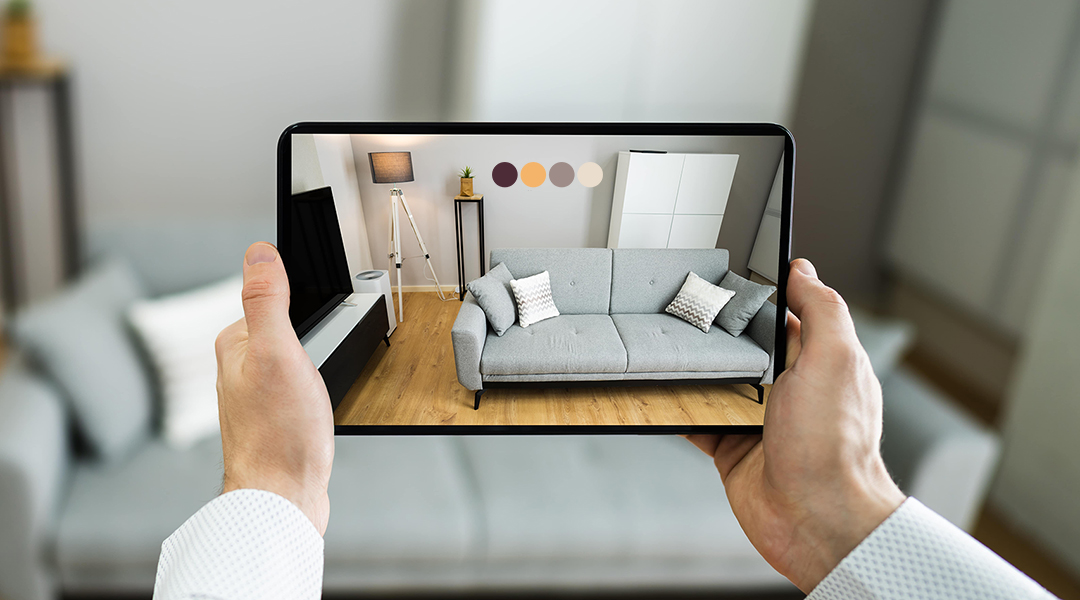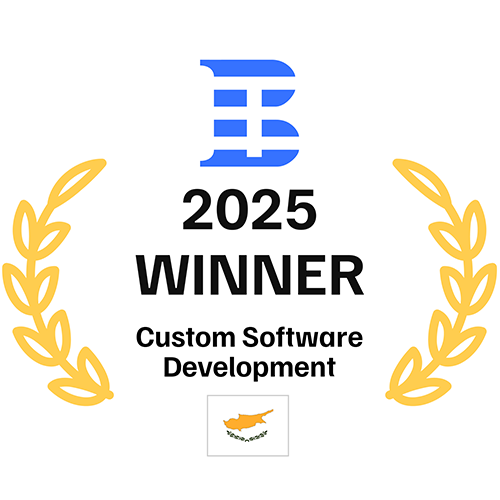Today the construction industry is in dire need of modernization, and some would say that custom VR development services are one of the best paths forward. Many industry experts firmly believe that tailor-made VR construction solutions can serve as an effective way to transform this sector. Despite substantial enhancements in the realm of construction materials, equipment, and safety norms over the past few decades, there's an undeniable reality in the industry that much of the work remains fraught with danger, inefficiency, and lacking in appeal for the new generation of potential workers.
Construction professionals, acutely cognizant of the issues besetting the industry, have begun to embrace VR in construction as a promising solution. For example, a recent survey of 33 top UK construction companies found that 36% of them are open to implementing the technology in their operations.
If you are intrigued by the prospect of leveraging this cutting-edge technology in your own company, you've landed on the right page. Our focus here is to delve into how virtual reality in construction can effectively address contemporary challenges faced by the construction industry, and the myriad ways in which it can enhance business performance.
We will also touch upon the role of VR as an innovative tool for training within this sector, harnessing the power of virtual reality to create immersive, effective training scenarios for safer and more efficient work practices.
Want to know more about virtual reality?
A VR experience is a digital and visual simulation delivered via a special headsets, which runs software with a 3D environment, 3D objects and characters, as well as interactive options that can be accessed with tracked movements. You can learn more about VR from the series published by Program-Ace.
Explore moreHow VR Solves Modern Construction Problems
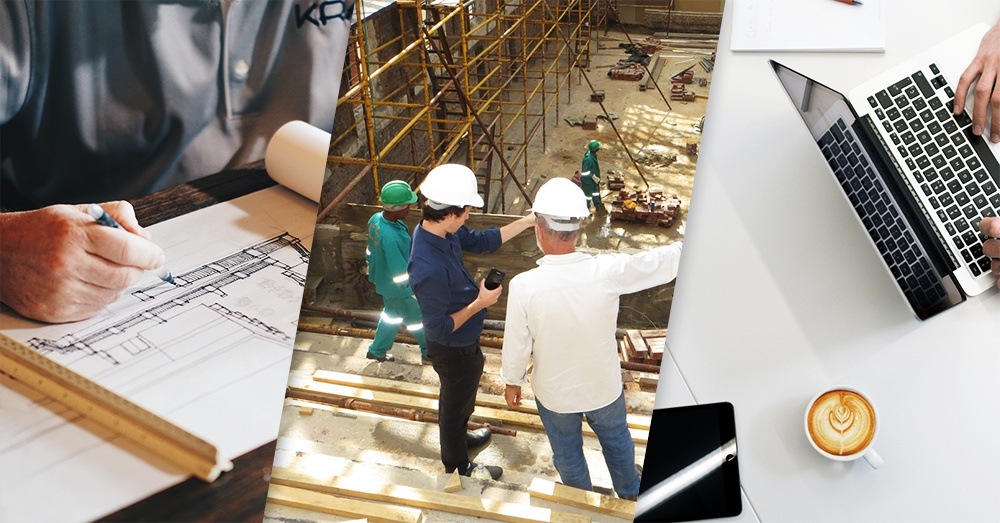
You may well be aware that construction is not a singular, linear process; rather, it encompasses many stages that a project must traverse. The noteworthy attribute of the VR in construction approach is its applicability that transcends individual steps or stages. This holistic characteristic of VR can be harnessed to address challenges faced by diverse specialists within the construction field.
Virtual reality in construction is not merely a tool limited to one stage or process; it can weave its technological magic throughout the construction journey. From initial planning and design to project execution and safety training, VR proves itself a robust ally.
Let's delve a little deeper into the multi-dimensional role of virtual reality within construction. Its potential to revolutionize the construction industry is significant, whether it's facilitating more efficient planning processes, fostering more engaging training methods, or providing virtual walkthroughs for quality checks and client previews. With VR, the reality in construction is shifting towards a far more technologically enhanced, efficient, and safe industry.
| Modeling and Architecture Problems | |
| 1. Reduce time spent on revisions | |
| What is the problem: The process of crafting intricate 3D models for a building or a complex is typically a time-consuming and challenging endeavor. This is particularly true when the model is initially grounded in an existing structure. Designers and architects often spend numerous weeks fine-tuning, revising, and repeatedly visiting the actual location to ensure the right degree of precision and detail in their conceptual model. This is where virtual reality in construction comes into play. The process can be significantly expedited and streamlined by harnessing VR in construction. Virtual reality construction allows designers and architects to virtually navigate the existing structure, providing them with a detailed and accurate sense of space and reducing the need for multiple site visits. | The solution: When a model is purposefully engineered for a VR experience, bolstered by including interactive options, it offers far greater adaptability to designers and modelers. This utilization of VR in construction enables them to swiftly evaluate alterations without remaking significant parts of the model. Moreover, it diminishes their reliance on frequent site visits or voluminous reference materials, thanks to the accurate simulation they can employ instead. This pivotal role of virtual reality in the construction industry adds flexibility and enhances productivity and accuracy. Designers and modelers can leverage virtual reality in construction to inspect every design element in a realistic and immersive 3D environment. This also allows them to identify potential issues that might not be apparent in 2D designs. |
| 2. Provide content reusability | |
| What is the problem: Establishing a streamlined collaboration between architects and the team responsible for project execution post-3D design completion can be daunting. This complexity arises as 3D designs are typically created with a single-purpose focus, such as for presentation or testing purposes. Consequently, adapting these designs to the actual construction work and integrating them into Building Information Management (BIM) systems often demands a significant investment of additional time. Herein lies the potential for an innovative solution facilitated by the application of virtual reality technology in construction. By leveraging VR in construction, the transition from 3D design to the realities of on-site construction becomes markedly more seamless. The virtual reality experience allows the project execution team to understand and interact with the design in an immersive environment. It gives them a deeper understanding of the project, reducing the likelihood of misinterpretations and errors. | The solution: Fortunately, models incorporated into VR software offer a significantly broader spectrum of applications, and their utility extends well beyond the preliminary planning phases of a project. With just a few adjustments, the software can be repurposed for the benefit of construction crews, engineers, and other stakeholders involved in the project. Such an approach eliminates the need for one team to discard or reconstruct 3D content, facilitating a seamless transition in project handover. So, now you are welcome to comprehend the power of VR in construction. It allows for integrating designs into a virtual reality platform, where they can be utilized across multiple stages of the construction process. The virtual nature of these models means they can be easily adjusted, shared, and interacted with, fostering better understanding and collaboration among various teams. |
| On-Side Construction Problems | |
| 3. Make training safer | |
| What is the problem: Training construction workers to identify and circumvent potential hazards on construction sites, reduce risk, and adhere to safety protocols is critical. However, providing new workers with practical experience without subjecting them to physical danger presents a significant challenge, as traditional training exercises often fail to replicate real-world conditions accurately. At this juncture, the inclusion of VR in construction training emerges as a transformative tool. By offering highly interactive, lifelike simulations that closely mimic actual construction site conditions, virtual reality in construction presents a trailblazing solution to this quandary. With VR, workers can gain hands-on experience in a controlled, risk-free environment. | The solution: Virtual reality safety training presents a zero-risk environment devoid of any physical danger. As long as the simulation enables your staff to interact with machinery, objects, and other elements common to their workplace, they can develop muscle and visual memory just as they would in a real-life scenario. Even when they cannot fully replicate certain movements with their hands, VR training allows them to witness events unfold realistically, offering invaluable experience. The use of VR in construction training provides unparalleled flexibility and convenience. Notably, VR construction training can be conducted anywhere without needing professional gear or heavy-duty equipment, making it a remarkably accessible and practical solution for the construction industry. |
| 4. Boost worker engagement | |
| What is the problem: Undoubtedly, motivation serves as a pivotal component in the realm of construction workers' productivity and efficiency. While an effective crew leader can maintain a disciplined and hardworking team, a decline in performance and work quality can be noted in workers who perceive their needs as overlooked. Using VR in construction presents innovative solutions in this scenario. By offering immersive and interactive training sessions, virtual reality in construction goes beyond skill enhancement, instilling in workers an understanding of their indispensable role in successfully completing a project. This understanding can invigorate their sense of responsibility, leading to augmented performance. | The solution: Most individuals generally find engaging in virtual experiences both enjoyable and intriguing. When these experiences are integrated into their work, curiosity and immersion don't fade but amplify, especially in the context of VR in construction. Workers tend to appreciate the opportunity to interact with such cutting-edge technology, mainly when it aids them in executing their daily tasks. In essence, implementing VR technology in the construction industry not only injects a sense of fun into the workplace but also leads to a more engaged, skilled, and efficient workforce. The fusion of virtual reality and construction work, thus, holds vast potential to revolutionize the industry, propelling it toward a future that is technologically advanced, productive, and enjoyable. |
| 5. Improve team coordination | |
| What is the problem: An ineffective organization often stands as a formidable barrier to efficient construction work. While it could be attributed to professional inadequacy, the blame usually falls on less grievous factors. For instance, the workforce may have needed better reference materials regarding the structure, or perhaps they still need to receive a detailed rundown of the day's planned activities. Harnessing the potential of VR in construction can play a transformative role in addressing this issue. Virtual reality in construction allows for a more detailed, comprehensive, and interactive presentation of reference materials. Through immersive VR simulations, workers can better understand the structure they are working on, enhancing their ability to perform their tasks accurately and efficiently. | The solution: A virtual digital replica is among the most potent resources and tools that can be offered to professionals in the field of construction. The power of VR in construction allows them to familiarize themselves with the intricate layout of a site thoroughly. But the benefits of virtual reality in construction continue beyond there. Additionally, these digital models provide an immersive preview of the tasks they are expected to carry out, thereby improving their task efficiency and readiness. Rehearsing their operations in a virtual environment allows them to streamline their collaborative efforts, honing their teamwork skills even before they set foot on the construction site. |
| Business Problems | |
| 6. Save on costs and materials | |
| What is the problem: Mitigating waste and redundancy is paramount in any construction project, especially for businesses focused on maintaining profitability, ensuring timely compensation for their workforce, and adhering to project timelines. Without meticulous planning regarding material usage and the scheduling of project activities, we often see materials being discarded or unused and specialized labor remaining unutilized at certain intervals. The power of virtual reality in construction can be harnessed to tackle these issues. We can ensure optimal use of materials and labor by enabling precise planning and prediction through VR in construction. Not only can VR help visualize the result, but it can also facilitate the step-by-step execution of the project, significantly minimizing instances of material waste, optimizing the utilization of skilled labor, and in a broader perspective, improving the overall efficiency of the construction industry. | The solution: By integrating accurate interactive elements into the virtual reality in construction, such as simulating concrete work or electrical wiring, construction crews are better equipped to make precise estimates concerning the required materials before making any purchases. This application of VR in construction can significantly streamline the procurement process. In addition, these detailed simulations can help teams pre-emptively identify potential structural issues. These digital previews of potential challenges can help avoid them from transforming into real, physical hurdles in the construction process. The result is a more effective and efficient workflow in the construction industry. Moreover, through these advanced virtual reality training opportunities, construction teams are further empowered to deliver high-quality results, enhancing the overall standard of the industry. Integrating virtual reality into the construction sector has revolutionized how we visualize projects and optimize the practical aspects of construction. The fusion of VR technology and construction offers a future where structures are erected with utmost efficiency and precision. |
| 7. Make your presentations effective | |
| What is the problem: The presentation phase is a pivotal juncture toward securing project approval and funding, and as such, it should not be taken lightly. Despite possessing an outstanding project concept and design, the likelihood of its success can quickly diminish if you cannot present it in a realistic and visually captivating manner. Stakeholders and investors are eager for comprehensive details and specifics. Virtual reality in construction can potentially revolutionize this stage of project development. Using VR in construction, you can offer an immersive, highly detailed tour of the proposed structure, allowing stakeholders to virtually walk through the project, experiencing it as though it were already built. The level of detail and immersion that virtual reality can offer goes beyond traditional presentation methods, helping to convey your vision more effectively. | The solution: An immersive presentation leveraged by virtual reality possesses a striking charm that goes above and beyond the capacity of a 3D render, paper model, or even an animated video to portray your project. Allowing potential stakeholders to experience your vision through VR in construction is an exceptional strategy for creating a captivating display. This compelling argument underlines why the use of VR for real estate is highly beneficial. In the construction industry, this new era of immersive technology helps prospective investors, clients, and other stakeholders to visualize, interact with, and understand the proposed structures in a much more realistic and engaging manner. |
How is VR Used in Construction? Top Examples
All over the world, we can find numerous instances of businesses using VR technology to improve their operations, and the construction industry is no exception. Let’s examine some notable cases in this field.
1. Singapore business center

The "BIM Visualization App" from Program-Ace was used to create a detailed 3D representation of this facility. The simulation encapsulates a substantial multi-level structure, encompassing views of the external facade, interior architecture, floor layout, electromechanical components, and an on-ground walkthrough. This provides an immersive, comprehensive perspective, improving facility management efficiency.
This piece of software catered to the requisites of the entity proposing the project while also addressing the requirements of the subsequent teams working on it — a range that included engineers, VR in construction crews, and maintenance staff. Moreover, this application of VR for real estate truly redefines our understanding of construction in the digital era.
2. New Rochelle downtown improvements

New Rochelle, a moderately populated city in New York, envisioned a revitalization of their downtown sector. To accomplish this, they opted for an innovative approach with the integration of VR in construction planning, designing an immersive platform that brought about three million square feet of projected enhancements and renovations to life with an all-encompassing 360-degree perspective.
This vivid virtual reality encounter was made accessible to the local residents via headsets and mobile devices, allowing the city planners to accumulate valuable feedback regarding the multitude of proposed transformations. This novel usage of VR for real estate and city planning exemplifies how technology is revolutionizing the construction industry.
3. VR Hotel
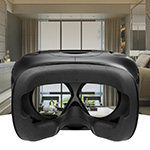
Program-Ace undertook yet another innovative projectin which a substantial hotel edifice, along with a supplementary simulation of the surrounding environment, was conceived through the implementation of VR in construction. Primarily crafted for promotional endeavors before actual construction took place, this virtual reality application introduced a plethora of interactive capabilities.
These encompassed navigation within the entire building structure, the personalization of room components and furnishings, and the transition between diurnal and nocturnal modes. Such an approach, combining VR for real estate with construction, represents an exciting frontier in the construction industry, transforming the way structures are envisioned, marketed, and built.
4. Hospital Nova
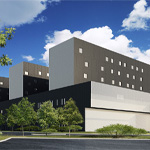
Nova, a sizable healthcare institution in Finland, is on the cusp of finalizing its construction phase. The enterprise spearheading the project harnessed the power of virtual reality in construction, leading to considerable influence on their project trajectory. This was achieved by creating a VR experience grounded in Building Information Modeling (BIM). The VR-BIM integration offered a detailed preview, ensuring seamless design execution.
For instance, this immersive experience was shared with the hospital personnel, eliciting their insights and proposals for modifications in the design. Moreover, it allowed the staff to familiarize themselves with their impending workspace, facilitating a smoother transition and adaptation process. Utilizing VR for real estate and construction is a revolutionary step forward in the construction industry.
5. Downtown resort

Embarking on a pioneering endeavor, Program-Ace took on a pathfinding project to ascertain the viability of constructing a sprawling resort in the heart of a bustling city. Our client sought our expertise, and we wholeheartedly accepted the challenge, leveraging our expertise in VR for real estate to create an immersive and realistic virtual environment. The resulting simulation profoundly influenced urban planning perspectives.
Within this digital realm, we meticulously crafted a captivating site, complete with an array of structures and a host of amenities. To enhance the user experience, we incorporated a dynamic walkthrough feature, allowing clients to navigate through the virtual space while providing limited interactive options to enrich their engagement further.
By harnessing the power of virtual reality in construction, we allowed our client to visualize their ambitious resort project, thoroughly examining its feasibility and potential. This cutting-edge application of VR technology showcases its transformative impact on the construction industry, empowering clients and developers to make informed decisions and unlock the true potential of their visions.
The Costs of VR in Construction
When considering the expenses associated with creating a VR experience, it becomes evident that these costs are relatively minor compared to the substantial budgets allocated for construction projects, which can easily soar into the millions or even billions of dollars.
Let's delve into some of the key components that contribute to the development costs:
Gathering visual references. Acquiring visual references of the desired location, whether through photographs, videos, or drone footage, forms an essential part of the VR experience creation process. While costs associated with this aspect are typically reasonable, it ensures the accuracy and authenticity of the virtual environment.
Hardware investment. Establishing a robust infrastructure requires investments in the necessary hardware, including powerful computers, servers, and testing devices. While this incurs upfront costs, it enables smooth VR application development and operation.
Software licensing. Securing appropriate software licenses is crucial for building and deploying VR applications. These licenses ensure compliance and provide access to the tools and frameworks essential for creating immersive virtual experiences.
Developer and designer compensation. Paying skilled developers and designers is a significant aspect of VR project costs. Their expertise and contributions are instrumental in bringing the virtual reality vision to life. While individual costs for certain tasks may not exceed a few thousand dollars, the overall salaries for the development team can reach tens of thousands of USD, commensurate with their experience and involvement.
In the construction industry, it is common for businesses to opt for cost-effective and practical solutions by engaging external firms and companies with expertise in VR for real estate or construction. This approach often proves more affordable than establishing an in-house team and ensures access to specialized knowledge and resources.
Considering the grand scale and potential benefits of incorporating VR into the construction industry, the investment in these VR experiences represents a worthwhile endeavor. It unlocks new possibilities for visualizing projects, enhancing stakeholder engagement, and ultimately contributing to the advancement of the construction industry as a whole.
Should You Use VR for Your Next Project? Let’s Review!
Even before VR became popular as a business solution, the construction industry already came to rely on BIM (which uses various software solutions), so VR apps seem like a natural extension of this trend. In the next few years, it should become even more apparent how virtual reality is changing architecture and adjacent industries.
Just to recap, businesses can get the following benefits of VR in construction:
Even if VR development falls outside your company’s area of expertise, you should know that creating such an experience is absolutely accessible. Hundreds of software development companies with experience in immersive solutions are operating on the market today, and you can certainly find a reliable partner that offers VR construction services.
Don’t know where to start? You are welcome to contact us, and we will gladly discuss how your project can be brought to life. Program-Ace has a long history of building solutions for this industry, and it would be an honor for us to help you improve operations and achieve your project goals.
FAQ
Virtual reality (VR) technology offers boundless opportunities for revolutionizing the construction industry. By immersing stakeholders in dynamic and realistic virtual environments, VR can redefine how construction projects are visualized, designed, and executed. Here are some exciting applications of VR in the construction industry:
Enhanced project visualization. Immerse stakeholders in a dynamic virtual realm where architectural designs and construction plans come to life. With VR, they can navigate through virtual representations of buildings, meticulously inspect intricate details, and comprehensively grasp the final product's essence even before a single brick is laid.
Virtual site inspections. You can step into the future of site assessment as VR enables architects, engineers, and construction professionals to conduct on-site inspections virtually. Through this simulated experience, they can walk through the construction site, scrutinize spatial relationships, spot potential clashes, and make well-informed decisions without the constraints of physical presence.
Collaborative design reviews. Architects, engineers, and clients can come together to review and refine design concepts by providing a shared virtual space. In this immersive environment, real-time feedback flows effortlessly, streamlining the design iteration process and ensuring an optimal result.
Virtual training and simulation. Empower construction workers with lifelike training simulations that enhance their skills and safety awareness. Through immersive scenarios, VR allows workers to practice complex tasks, from equipment operation to handling hazardous environments, all within a controlled and secure virtual setting.
VR for real estate. You are welcome to revolutionize real estate marketing with captivating virtual tours transporting prospective buyers into immersive exploration. VR enables them to navigate virtually through homes, offices, or even entire developments, gaining a true sense of spatial layout, aesthetics, and ambiance. This unparalleled experience elevates property presentations, ignites engagement, and accelerates decision-making.
Remote client engagement. Overcome geographical boundaries and connect with clients and investors regardless of their location. VR enables remote stakeholders to actively participate in project reviews, walkthroughs, and design discussions, bridging the physical divide. By being virtually present, they can provide invaluable input, contribute to the decision-making process, and drive project success.
By harnessing the power of VR in construction, the industry can elevate project visualization, improve collaboration, streamline processes, enhance safety training, and boost marketing efforts. As technology advances, VR is set to reshape the construction industry, offering unprecedented opportunities for innovation, efficiency, and enhanced stakeholder experiences. Embrace the virtual revolution and unlock the full potential of VR in construction.
Welcome to the forefront of construction innovation, where the convergence of virtual reality (VR) technology and the construction industry opens up a world of endless possibilities. In this dynamic landscape, VR has emerged as a powerful tool for transforming how projects are visualized, planned, and executed. Here are the benefits of using VR in construction projects:
Enhanced design visualization. Experience the power of virtual reality (VR) in construction as it brings architectural designs to life. Immerse yourself in a virtual realm where you can explore every project detail, from structural elements to interior finishes. With VR, you can comprehensively understand the design concept, ensuring accuracy and reducing errors before construction begins.
Efficient planning and coordination. By creating virtual construction site models, stakeholders can visualize the entire project. They can virtually walk through the site, examine spatial relationships, and identify potential clashes or conflicts, streamlining the planning process and minimizing costly rework. Therefore, VR in construction revolutionizes project planning and coordination.
Enhanced safety training. Also, VR offers a safe and controlled environment for construction workers to undergo immersive safety training. Through realistic simulations, workers can practice hazardous scenarios, such as working at heights or operating heavy machinery, improving their skills and safety awareness. VR training reduces the risk of accidents on site and ensures compliance with industry regulations.
Improved client engagement. VR technology elevates client engagement by providing immersive virtual tours of construction projects. Clients can visualize the final product, explore different design options, and make informed decisions. This enhanced engagement fosters better communication between stakeholders and increases client satisfaction.
Streamlined collaboration. With virtual meetings and shared virtual spaces, architects, engineers, and contractors can work together in real-time, regardless of their physical locations, eliminating the need for costly and time-consuming site visits and accelerating decision-making as well as project progress. Well, that's how VR facilitates seamless collaboration among project teams.
Accurate cost estimation. VR allows for accurate cost estimation by providing a detailed virtual representation of the project. By virtually visualizing all aspects, from materials to labor, stakeholders can make precise cost calculations, helping to optimize budget allocation and reduce financial risks.
Real estate visualization. Virtual reality is undoubtedly a game-changer for the real estate industry. With immersive virtual tours, potential buyers can explore properties remotely, experiencing the space as if they were physically present. VR for real estate enhances marketing efforts, attracts more qualified leads, and expedites sales.
Embrace the transformative power of VR in the construction industry. From enhanced design visualization to streamlined collaboration and improved safety training, VR offers many benefits that enhance efficiency, accuracy, and client satisfaction. Embrace VR and unlock new possibilities for success in the dynamic construction industry.
Virtual reality (VR) simulations have revolutionized the construction industry, offering many benefits that can significantly reduce costs and minimize risks. With immersive virtual environments and cutting-edge technology, VR simulations transform how construction projects are planned, executed, and managed. Let's explore how VR simulations can revolutionize cost reduction and risk mitigation in construction:
Enhanced project visualization. By harnessing VR for real estate, architects, engineers, and designers can explore and refine construction plans in a visually immersive virtual realm. This enables them to identify and rectify design flaws and complexities before construction begins, resulting in cost savings.
Precise cost estimation. VR simulations provide a detailed and interactive representation of the project, allowing stakeholders to assess material quantities, labor requirements, and potential project intricacies. Accurate cost estimates mitigate budget overruns and financial risks.
Improved safety training and awareness. VR-based training programs create realistic and risk-free environments for construction workers to practice safety protocols. Immersive simulations enable workers to develop skills and improve safety awareness, reducing accidents and associated costs.
Streamlined collaboration and communication. VR simulations facilitate seamless collaboration among project teams by creating a shared virtual space. Architects, engineers, and clients can virtually interact with the model, providing real-time feedback and enhancing communication efficiency.
Early clash detection and conflict resolution. Through VR simulations, clashes and conflicts between different building systems, such as electrical, plumbing, and HVAC, can be detected and resolved early. This proactive approach minimizes costly rework and project delays.
Enhanced stakeholder engagement. VR simulations offer stakeholders, including clients and investors, an immersive virtual walkthrough of the proposed project. This engaging experience enables stakeholders to understand the project comprehensively, fostering trust and reducing uncertainties.
Efficient project monitoring and progress tracking. VR simulations enable project managers to monitor construction progress and track deviations from the planned schedule. This real-time monitoring allows for timely interventions, ensuring project completion within the set timeframe and minimizing additional costs.
With the integration of VR simulations, the construction industry can achieve significant cost reductions, streamline project workflows, and mitigate risks effectively. Embracing this innovative technology creates new possibilities for improved project outcomes and enhanced stakeholder satisfaction.



